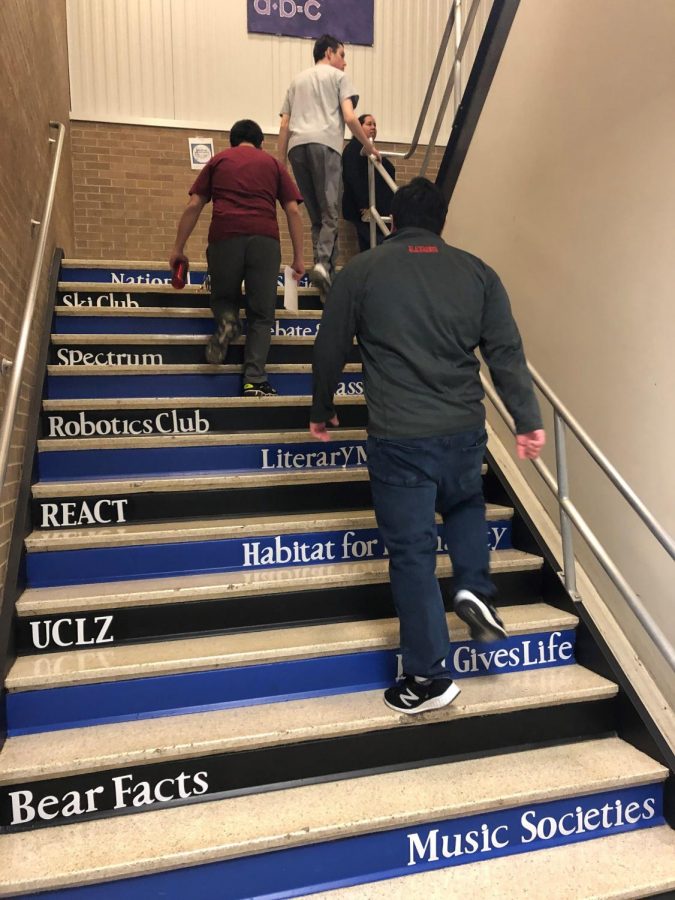The story behind the stalls
How Stall Street Journal gets in every bathroom, and the unresolved threat that it faces
Second period: Silence fills the halls, students fill the classrooms, and the transition class is hard at work.
Ever since it was first printed in 2012, transition students have taken on the role of distributing the Stall Street Journal in every bathroom of the school, says Annamarie Bader, teacher of the transition class. This is just one of the many job opportunities for the students to gain skills to be successful later in life, Bader says.
“This job is just another skill they can work on, and they are pretty good at it. It helps them work on their organizational skills, and it helps them visually to read and tell which [Stall Street] is the old one and which is the new one,” Bader said. “We actually sit down and read it as a group to make sure they understand it, it’s a positive thing for my students.”
This job’s purpose goes beyond gaining useful skills, Bader says, and also gives the transition students a rewarding experience. Since these students have already graduated, distributing Stall Street is a great opportunity to relive a high school experience, and they are clearly excited about it, Bader says.
“Just the fact that they are asking about [distributing], they always ask when they get to do it again. [The students] love walking around the campus, and they miss being high school students in some way and being involved,” Bader says. “They know they are helping teachers do this, and they know they are doing a good job, and that’s rewarding enough for them.”
By helping teachers with distribution, the transition students help spread important information, Barbara Belke, social worker who writes the Stall Street Journal, says. There is always a variety of crucial information on the Stall Streets, like “healthy choices, so there’s always something in there regarding [hygiene or best practices], and there are obviously some jokes,” Belke says. The school also [puts] in current events that are happening here at the school, days off, charity bash, those kinds of things.”.
Knowing those things like charity bash or other major events helps get students involved and excited in the school, but that consumer tips are just as important. Written information that students need to know “gives an opportunity to think about it and make decisions based on the information you receive,” Belke says. “Hopefully that information will encourage consumers to do a little more exploration and investigation to make sure that when you are making those choices, you are doing something that is good for you.”
The transition class tries to distribute that information as effectively as possible, and takes their job very seriously, Bader says. Whenever the students go out to put the Stall Streets in the bathroom, Bader says they are meticulous in making sure every part of the process is done right.
“They take the old ones out, and put the new ones into the plastic cases that Ms. Belke has installed. We may put two or three of the students in charge of taking the old ones out, and they have to be really careful not to break the cases,” Bader said. “And then we have a couple more who put the new ones in. We have some higher level students who can do some quality control in that area too.”
However, sometimes this hard work is ruined, especially in the boys bathrooms. Aman Patel, sophomore, says this vandalism is happening in the boys bathrooms specifically because boys are more “mischievous”.
“Boys are crazy dudes, they are a crazy breed, and girls are just more chill,” Patel said. “It’s so disrespectful in my opinion, I mean there are are some really inappropriate things they are putting on there, things that should not be discussed. They think it’s funny but it’s not.”
While some students do not appreciate stall street as much as they could, transition students continue to work their hardest to distribute it, Bader says. The vandalism problem is one that is difficult to solve, according to Bader, and is a big disruption to her students when they post the Stall Streets.
“They break off [the plastic containers where the Stall Streets go] so there’s no place to put them. So we’ll tape them on, but they don’t stand, somebody rips them off,” Bader says. “I don’t know how to control that, possibly putting something out that this is really considered vandalism, I mean a lot of work goes into this. It seems like someone should be disciplined for it, but it’s hard to tell who’s really doing the vandalism.”
While this vandalism is disappointing, Bader says there is no way to really make it stop. Until then, Bader says her students will be ready every two weeks to replace the Stall Streets, no matter how difficult it is.

As a senior, this is Max’s third year on staff and first year as magazine editor in chief for the Bear Facts program. He aspires to study environmental...

